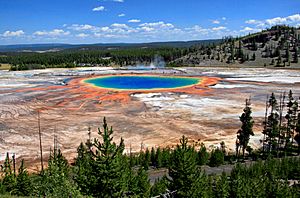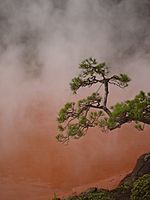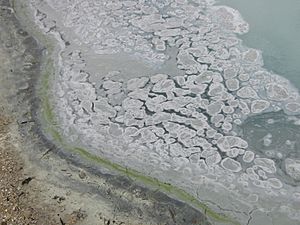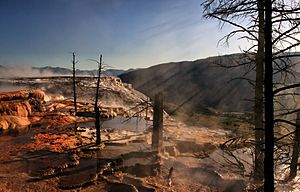Hot spring facts for kids

A hot spring is a spring produced by the emergence of geothermally heated groundwater from the Earth's crust. There are hot springs all over the crust of the earth.
Definitions

There is no universally accepted definition of a hot spring. For example, one can find the phrase hot spring defined as
- any geothermal spring
- a spring with water temperatures above its surroundings
- a spring with water temperatures above 50 °C (122 °F)
- a natural spring with water temperature above body temperature – normally between 36.5 and 37.5 °C (97.7 and 99.5 °F)
- a natural spring of water greater than 21.1 °C (70 °F) (synonymous with thermal spring)
- a natural discharge of groundwater with elevated temperatures
Water Temperature

The related term "warm spring" is defined as a spring with water temperature less than a hot spring by many sources, although Pentecost et al. (2003) suggest that the phrase "warm spring" is not useful and should be avoided. The US NOAA Geophysical Data Center defines a "warm spring" as a spring with water between 20 and 50 °C (68 and 122 °F)
Water issuing from a hot spring is heated geothermally, that is, with heat produced from the Earth's mantle. In general, the temperature of rocks within the earth increases with depth. The rate of temperature increase with depth is known as the geothermal gradient. If water percolates deeply enough into the crust, it will be heated as it comes into contact with hot rocks. The water from hot springs in non-volcanic areas is heated in this manner.
In active volcanic zones such as Yellowstone National Park, water may be heated by coming into contact with magma (molten rock). The high temperature gradient near magma may cause water to be heated enough that it boils or becomes superheated. If the water becomes so hot that it builds steam pressure and erupts in a jet above the surface of the Earth, it is called a geyser. If the water only reaches the surface in the form of steam, it is called a fumarole. If the water is mixed with mud and clay, it is called a mud pot.
Note that hot springs in volcanic areas are often at or near the boiling point. People have been seriously scalded and even killed by accidentally or intentionally entering these springs.
Warm springs are sometimes the result of hot and cold springs mixing. They may occur within a volcanic area or outside of one. One example of a non-volcanic warm spring is Warm Springs, Georgia (frequented for its therapeutic effects by paraplegic U.S. President Franklin D. Roosevelt, who built the Little White House there).
Related pages
Images for kids
-
Grand Prismatic Spring and Midway Geyser Basin in Yellowstone National Park
-
Algal mats growing in the Map of Africa hot pool, Orakei Korako, New Zealand
See also
 In Spanish: Aguas termales para niños
In Spanish: Aguas termales para niños










